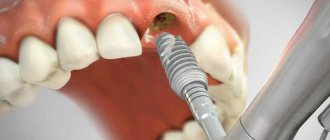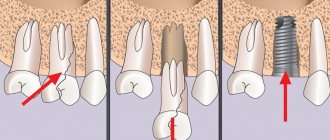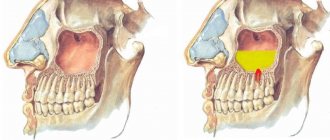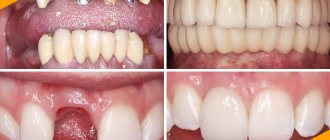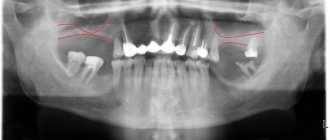Most of women's knowledge about how pregnancy begins ends at the stage of ovulation and fertilization. Actually, the success or failure of the planning cycle is attributed to the fateful “meeting” of male and female reproductive cells. However, in the development of a new life in a woman’s body, there is another difficult and important point - embryo implantation . In order to increase the personal literacy of planning ladies, this issue should be given special attention.
Why implantation?
All methods of dental prosthetics prior to implantation negatively affect the condition of the oral cavity in the future, often causing premature wear and loss of teeth. In particular, the manufacture of bridge-like prostheses - bridges, as they are also called - requires the depulpation and preparation of two, and sometimes three, teeth to replace just one lost tooth.
Such radical treatment, to put it mildly, is not beneficial for the jaw system and leads to overload of the supporting units with further root inflammation and tooth loss. At the same time, the average service life of “bridges” is 6-7 years.
The situation with removable dentures is even more complicated: for any removable device, the support is the gums and bone tissue of the jaw, which, in principle, is not adapted to a full chewing load. As a result, a chronic inflammatory process develops, and the bone atrophies and dissolves.
On what day does embryo implantation occur?
The development of a normal pregnancy is possible only after proper implantation.
In order to find out on what day implantation occurred, you should find out the date of ovulation, since the calculation is made from this time. It is believed that the time for implantation of the embryo into the uterine mucosa is the 9th day after ovulation and expected fertilization. In almost half of the cases such calculations are correct.
Of these 9 days after fertilization and before implantation, 6 days the egg moves through the fallopian tubes, where it simultaneously divides. During this period of time, the egg goes through three stages of development - zygote, morula and blastocyst, and the rest of the time the embryo “floats” in the uterine cavity, until the preparation processes for implantation are completed. That is, the average time is 9 days, but implantation can occur either after this period or earlier.
What to prepare for
Dental implantation is a technique that does not have the disadvantages of previous generations of prostheses. Implantologists consider it as the only way to restore lost teeth that does not harm the health of the oral cavity and has an unlimited (usually lifelong) service life.
Important! No other prosthetic method provides such high aesthetics as implantation.
But it should be taken into account that dental implantation is not a simple procedure during which an implant is simply inserted in place of the missing unit. The future tooth (more precisely, its root) must have a certain size, the proper position and direction, and a strictly defined inclination are selected for it.
In addition, it is necessary to restore all the tissue surrounding the tooth - and, first of all, bone tissue and gums. It is this comprehensive approach that allows us to achieve reliability, impeccable aesthetics, and durability of implant treatment.
Implantation is a slow process, except for one-stage implantation, as well as the “all on 4” and “all on 6” techniques. Treatment usually involves several stages, despite the common name of "two-stage" surgery.
Treatment always begins with diagnosis, which is the first and, perhaps, the most important stage that determines its outcome. Based on the results of the preliminary examination, a decision is made on implantation technology, types of implants, and the details of the upcoming operation are thought out.
Important! It is necessary to prepare for the fact that during the implantation process you will have to go through several stages. A standard scheme applies to all patients, so we have prepared a detailed description of each stage of dental implantation.
A little theory
Introduction of fertilized egg into the uterus
called implantation. The embryonic villi penetrate the lining of the uterus, which may cause minor bleeding.
In order for implantation to be successful, several conditions must be met:
- lush three-layer endometrium with a high content of substances that nourish the embryo;
- high amount of progesterone in the body (so that the embryo can develop and menstruation does not begin);
- normal microflora in the body.
The process of fertilization and development of the fertilized egg is not a one-step process. And each stage is important for the onset of a normal pregnancy and the formation of a healthy fetus.
Stage 1: diagnosis
It may take some time to choose a clinic and an implantologist, since this is one of the key points in the whole story. In addition, you need to get to know the orthopedist and, if necessary, the therapist - these doctors will also take part in the process of implantological treatment. If everything is satisfactory, then before implantation an examination is carried out by a surgeon.
He will tell you whether it is possible in principle to place an implant in this patient, and will develop further treatment tactics based on the following data:
- general oral health;
- the presence and condition of neighboring teeth and gums, which are located next to the future implant root;
- bite;
- hygiene quality;
- financial capabilities of the patient.
The price is usually included in the total cost of treatment, which is carried out in most clinics on a turnkey basis. The doctor will announce the approximate cost, the final price is determined after diagnostic testing and consultation with an orthopedist. If a patient needs the help of a physician, hygienist or periodontist, then their services should be considered.
Diagnostics includes instrumental and laboratory studies, without which surgery is impossible. These examinations are necessary to exclude a number of complications after the introduction of implant rods and achieve extremely good treatment results.
Reasons for non-attachment of the fertilized egg
Each patient has an individual response to IVF procedures, so late implantation may not take place.
The most common reasons for rejection:
- embryo with genetic abnormalities;
- poor quality material;
- unhealthy endometrium;
- exacerbation of chronic pathologies of a woman during an IVF program;
- the patient's age is 35 years or more;
- unexpected disorders of the reproductive system.
If late implantation fails, an examination is carried out, the doctor analyzes the situation, draws conclusions about the reasons for the failure, draws up a diagnostic and IVF program taking into account the information received.
Read more about cryotransfer after unsuccessful IVF in this material - note. altravita-ivf.ru.
Instrumental studies – tomography and x-ray
They are performed on all patients, regardless of the chosen implantation technology. Based on the data obtained, the issue of the types of implants and the methodology of the implantation operation itself will be decided.
An X-ray is taken selectively, precisely in the part of the jaw where implants are planned to be installed. Using it, the doctor evaluates the condition and location of the roots of the teeth, near which the implant should be installed. The price of such a photo starts from 700 rubles.
A panoramic photograph is needed for any type of prosthetics, and implantation is no exception. Otherwise, it is called an orthopantogram and is performed to take into account the characteristics of the bite and the condition of the bone tissue. All this is of great importance, since a strong foundation is extremely important for the implant root.
The price of a 3D image - orthopantogram - from 1500 rubles.
But the most important study at the diagnostic stage is CT - computed tomography. Without it, not a single dental implantation operation is performed, and neither an X-ray nor an orthopantogram can replace it.
Computed tomography is the most expensive examination at the diagnostic stage, the price of which starts from 3,000 rubles. Based on its results, the quality of bone tissue is assessed, the sites for installing implants and their type are selected. It is the tomogram that allows the implantologist to conclude that bone grafting is necessary if there is insufficient bone volume.
Modern medical centers where implantation operations are performed are equipped with high-precision equipment and use navigation programs. All this makes it possible to plan the course of treatment in detail and even show its future results to the patient!
Lab tests
The diagnostic stage before implantation necessarily includes a general and detailed blood test. This is a must for everyone. Certain categories of patients will need to provide the results of hormone tests (usually women) and other specific laboratory tests if there are concomitant pathologies.
A number of diseases are a relative contraindication for surgery to install implants, and then a preliminary consultation with a specialist is necessary. If necessary, before implantation, the condition is corrected to acceptable levels (for example, in the case of diabetes).
The price of sample collection services may vary and depends not only on the number of studies. Many tests are done in district clinics, and will be free if referred by a doctor. Thanks to this approach, diagnostic costs can be significantly reduced.
At the diagnostic stage, all patient data is collected, and based on the information obtained, the optimal method of dental implantation and type of implants are selected. After agreeing on the finished plan with the client, we begin to implement it. Next begins the stage of preparation for the implantation operation.
Dental implantation – rating of clinics.
Clinic ratings are a special list that is compiled based on patient reviews and ratings.
It is with the help of the rating that you can find out which clinic provides quality services and which one is better not to contact. They try in every possible way to make the rating as honest as possible; for this purpose there is a team of moderators that blocks all suspicious ratings and reviews. You can read reviews about any clinic and choose the best one for yourself. Our network of dental clinics received a rating of 4.3 out of 5.
During the operation of our medical centers, more than 5,000 thousand operations related to dental implantation were performed.
Our branches are represented in the South-Western Administrative District, Southern Administrative District, and Northern Administrative District of Moscow.
Stage 2: preparatory
Details of the preparatory stage may vary significantly for different patients due to differences in the condition of the oral cavity in general and the jaw bone tissue in particular. Most people planning to have implants require dental hygiene.
Sanitation is carried out with the aim of eliminating bacterial plaque from the surface of tooth enamel, since a successful implantation operation requires, if not sterility, then maximum cleanliness of the oral cavity. The presence of pathogenic microflora can provoke the development of inflammation, which should be avoided at any stage of implantation.
Hygienic cleaning is done using ultrasound when there is existing tartar, soft plaque is removed using Air Flow technology. The price of such reorganization is from 6,000 rubles.
At the preparatory stage before implantation, it may also be necessary to remove teeth, treat caries and periodontitis. The price of each procedure is calculated separately.
But the most serious step before installing implants may be bone grafting surgery. Very often it is impossible to do without it due to a lack of bone due to its resorption - resorption, natural loss. Bone volume can be greatly reduced if a tooth is lost or removed long ago, or due to individual characteristics.
As a rule, bone grafting is performed in the case of classical two-stage implantation, which places high demands on the quality of the jaw bone tissue. In addition, bone grafting is almost always necessary for patients who have lost teeth a year or more ago. During this period, the bone undergoes rarefaction and becomes brittle, which creates certain difficulties with fixation of implant roots.
There are several methods for performing bone grafting, or osteoplasty, using different materials. Therefore, the price will depend on the selected operation technology. There are 3 options in total:
- sinus lift;
- directed regeneration;
- autotransplantation.
When the fertilized egg attaches later
During IVF, blastomeres are cultivated for 3–5 days, after which the highest quality embryo is transplanted into the uterus. The entire process from fertilization, cultivation, embryo selection to replantation takes 5–8 days. Therefore, late implantation is more typical for IVF . In addition, with artificial insemination, the embryo needs more time to adapt. For successful late embryo implantation
Sufficient production of progesterone by the female body is necessary. The success of the embryo transfer process can be judged by the increase in hCG produced by chorionic tissue one day after successful attachment. An ultrasound visualizes a small (2 mm) fertilized egg.
Late embryo implantation is no different from early or middle implantation in terms of possible negative impact on the course of pregnancy, on the development and health of the fetus.
To avoid rejection during late implantation, a woman is recommended to:
- avoid intimacy at first;
- do not take baths, do not visit saunas, steam baths, avoid any thermal procedures, including exposure to the sun (if the procedure takes place in the summer);
- do not lift heavy objects;
- do not engage in sports or active activities;
- do not overcool;
- avoid psycho-emotional overloads, to which sex and gonadotropic hormones that support pregnancy are highly sensitive.
Read more about what to do after embryo transfer in this material - note. altravita-ivf.ru.
Sinus lift
Sinus lift or subantral augmentation surgery before implantation can only be performed on the upper jaw. Its essence is to raise the lower septum of the maxillary sinus in order to increase the space of the alveolar ridge. The space thus freed is filled with bone tissue.
On a note! Sinus lifting is scientifically called subantral augmentation.
If there are no contraindications, the implantologist can combine sinus lifting with the installation of implants. Otherwise, the latter are placed in the jaw bone 3-6 months after the subantral augmentation surgery.
Sinus lifting can be open or closed, and its price depends on the chosen method. Open operations are estimated at the amount of 40,000 rubles, closed ones - from 20,000 rubles. It is important to know that this cost does not include the price of the bone material itself.
Autotransplantation (autologous transplantation)
Another type of bone grafting performed before implantation. It is essentially a self-transplant since the recipient is his own donor. A similar technique is used for extensive burns, when areas of the patient’s healthy skin are transferred to the burned areas.
A similar technology is widely used by implantologists. During surgery, bone blocks taken from the patient are implanted into the jaw bone. The recovery period after installing implants using autologous transplantation is quite long and can last up to six months.
Implantation of implant roots is possible after completion of osseointegration, after 6 months. The asking price is at least 50,000 rubles.
Stage 3: installation of implants
If bone grafting was performed, then the stage of dental implantation itself proceeds six months after the healing of the jaw tissue and successful integration of the bone. Surgical treatment for implantation of implant roots, in turn, is also divided into several stages, including:
- Stage 1 – pain relief. The type of anesthesia is planned at the diagnostic stage, and its choice depends on the scope of the intervention. When installing 1-2 titanium rods into the jaw, local anesthesia is usually given. If there are more, implantation may require general anesthesia or sedation;
- Stage 2 – incision of the gums and periosteum to gain access to the surgical field;
- Stage 3 – drilling a hole for the implant root in exact accordance with its dimensions and forming notches on the walls of the hole for better fixation of the future tooth in the jaw. The prepared hole is treated with an antiseptic, dried, after which the implantologist begins to screw in the implant itself;
- Stage 4 – installation of a plug to prevent tissue from growing inside the implant root;
- Stage 5 – suturing the gums and suturing. Implantation is complete.
On a note! Implant sedation is often chosen by patients who experience panic attacks before dental treatment. It is also indicated for people with heart disease and hypertension. Sedation is a safer alternative to general anesthesia, which is advisable to use for multiple dental implantations and bone grafting.
After the implants are installed, the patient is under the supervision of a doctor for some time, who at the same time instructs him regarding further treatment and care. If there are no signs of complications, after a couple of hours the person goes home, where he takes medications to speed up the healing of the gums and stimulate the osseointegration of the implant roots. In addition, he is given a leaflet with recommendations regarding oral hygiene after implantation.
The sutures after implantation are usually removed after a week, then a temporary crown can be installed. The price of the main stage largely depends on the type of implants.
If the pain in the implant area does not go away for a long time
Prolonged pain may indicate the development of complications . You should be especially alarmed by sharp acute pain a few days after implantation. If, along with pain, accompanying negative symptoms appear, this indicates that an inflammatory process has begun in the tissues around the implant, which will interfere with osseointegration. Failure of the fusion of the implant with the bone bed can lead to rejection of the titanium root.
Signs of complications:
- implant mobility;
- increased pain when pressing on the structure;
- increased body temperature;
- swelling and redness of the mucous membrane;
- discharge of pus;
- bad breath;
- enlargement of the submandibular lymph nodes.
Treatment with folk remedies or self-medication with painkillers will only help reduce symptoms, but will not solve the problem and may even worsen it.
Stage 4: rehabilitation after implant installation
The rehabilitation period is the time during which the implant root takes root in the patient’s own tissues. Only after osseointegration is completed can one proceed to the orthopedic stage and place permanent crowns.
It is impossible to shorten the healing time of implant roots, even if you take special calcium supplements and other medications. Depending on individual characteristics, it can average 3-6 months, although in most cases it takes at least six months.
The implantologist may recommend regular visits to the clinic to monitor the survival of the implant root (or roots). However, in the absence of discomfort and complications at the rehabilitation stage, the patient makes the next visit to the clinic at the very end. Next, a date is set for placing a gum former on the implant.
Stage 5: insertion of the healing abutment
This detail is necessary to give natural contours to the gums in the operated area. The former is screwed directly into the implant rod by cutting the soft tissue.
In essence, the plug is replaced, which is unscrewed, and a former is placed in its place in the implant channel. The manipulation is very simple and quite fast. An experienced implantologist performs it in a matter of minutes, maximum in half an hour, regardless of the type of implant. But an anesthetic injection is still given due to the incision of the mucous membrane.
This is where the main and most serious part of dental implantation ends, and after a week or two they move on to screwing in the abutment.
Step 6: Abutment Installation
The abutment is screwed directly into the implant root; it is the abutment that is the connecting link between the implant and the crown/prosthesis. The abutment is installed 2 weeks after the former and is selected individually for each client.
For example, when implanting teeth in the smile area and thin gum tissue, it is recommended to install zirconium abutments, since titanium “spare parts” can negatively affect aesthetics.
Placement of the abutment completes the implantation procedure and treatment continues with the prosthodontist.
How are dental implants placed?
Very often people ask what to do if one tooth is lost. Is it possible to restore it using implantation, without grinding down healthy teeth?
First of all, you need to consult with an orthopedic surgeon involved in implantation. After examining the oral cavity, he will tell you how dental implants are placed. It will also be necessary to undergo a preliminary examination with x-rays, a tomograph, and donate blood for tests. After this, the implantation procedure will begin. If insufficient bone tissue volume is detected, it will be increased before installing the implant.
Stage 7: prosthetics
After 1-2 weeks from the installation of the abutment, impressions of the teeth and jaws can be made. Crowns can be made from absolutely any material, but ceramic products are more suitable for front teeth. Implant roots in the area of chewing teeth are complemented by metal-ceramic or zirconium crowns.
The price of prosthetics varies depending on its type, since both crowns and removable, as well as conditionally removable dentures are placed on implants. In addition, the cost is affected by the material they are made of.
On a note! Zirconium is the most expensive, but also the most reliable material, which has high strength and excellent aesthetic qualities.
Life after implantation
Once the implants have settled in and the crowns have been placed, it is important to properly care for them in order to maintain the results for as long as possible. The rules for caring for teeth with implant roots are standard, but with some peculiarities.
Firstly, you should use a brush with medium-hard bristles to avoid traumatizing the mucous membranes and ensure high-quality cleansing of new teeth. An implantologist or orthopedist will advise which paste is best to choose.
Secondly, it is advisable to rinse your mouth after every meal, but alcohol-based rinses are not suitable for this due to their ability to dry out the mucous membranes. A person with installed implants should have dental floss and an irrigator in their arsenal.
On a note! Insufficiently careful care of teeth on implants can shorten their service life and even lead to rejection.
Thickness of the endometrium of the uterus
Insufficient thickness of the endometrium of the uterus is a fairly serious and significant reason for the failure of in vitro fertilization.
Thin, immature endometrium is not able to provide the embryo after implantation with sufficient nutrients necessary for its development. In addition, it does not perform a sufficient secretory function. This factor also affects the further course of pregnancy.
Factors that influence embryo maturation:
- uterine hypoplasia and associated hormonal imbalances;
- previous injuries, inflammatory processes that impair blood circulation in the uterus;
- traumatization of the endometrium, which arose due to frequent curettage and abortions.
A preliminary assessment of the condition of the uterus and the degree of its maturity is possible only after an ultrasound examination, during which the thickness of the walls of the uterus, their condition, the presence of defects and developmental disorders are determined.
One-stage, instantaneous implantation
Dental implantation of teeth can be not only two-stage, but also one-stage, one-step. If you choose one of these procedures, the installation of implants will take much less time, at least due to the absence of the need to build up bone before implantation.
In one stage, implantation is performed in two cases: with satisfactory bone condition and the use of special types of implants. During surgery, the implant is installed, and a temporary crown is immediately placed.
Unlike one-stage implantation, one-stage implantation involves the simultaneous removal of a tooth and the introduction of an implant into the same hole. But, like one-stage, one-stage implantation is performed with immediate loading, that is, after installing the implant, an abutment is immediately screwed onto it and a temporary prosthesis is placed.
Important! A temporary prosthesis on an implant can be replaced with a permanent structure after six months.
Classic one-stage implantation is also called non-surgical express implantation. It has a number of advantages, since the client:
- saves time - implants are installed in one visit to the doctor;
- saves money - the final cost of one-stage implantation is lower than classical two-stage implantation;
- obtains excellent aesthetics even in the absence of most teeth - and in the case of complete edentia, a dazzling smile can be achieved within 3 days;
- recovers quickly after installation of implants, and with a lower risk of infection, swelling and other complications, since simultaneous implantation is performed without an incision or stitches.
Thus, implantation in one visit to the dentist is the best solution, since it allows you to do without bone augmentation, which means saving time, money and preserving your own bone tissue in the area of the implant root.
How to calculate the cost of implantation?
When dental implantation is performed on a turn-key basis, the cost that is initially set may increase due to other additional operations and services. The cost of additional procedures is negotiated separately and is charged on top of the established price. In general, when choosing this method, the patient receives guarantees of high-quality execution of the procedure, since it is much easier for the doctor performing the operation to monitor the patient’s condition.
To calculate the cost of any type of implant installation, you can use a special calculator. Dental implantation is a rather complex procedure, when calculating the cost of which many points must be taken into account - the cost calculated on the calculator is highly accurate, since all these points are taken into account. However, do not forget that the exact price of dental implantation is discussed with a specialist doctor during the initial examination.
How much do dental implants cost?
The question is quite controversial, since there are many manufacturers, as well as promotional offers from various clinics. Price components include the cost of implants, crowns and other materials.
Of course, an implant can be found at a price of about 20,000 rubles per unit, but it is unlikely that anyone will be responsible for the quality. Moreover, it is worth paying more attention to new, unverified manufacturers. On the Russian market, these are representatives of South Korean brands that quite actively import dental implants. The cost of their products can range from 20 to 50 thousand rubles per implant. In addition to these countries, implants are produced by the USA (SuperLine, Bicon) - cost 50 and 75 thousand, respectively, Israel (Alpha Bio, MIS) - cost 25-36 thousand rubles, Switzerland (Strauman, Nobel Biocare) - from 50 to 100 thousand rubles per one implant, France (Anthogyr) – 48 thousand rubles, Germany (Ankylos) – 60 thousand rubles, Sweden (Astra Tech) – 65 thousand rubles.
Which brand to choose is up to you to decide, but it may be a good idea to read reviews from patients on specialized forums who have already undergone this procedure and can share their experience and recommendations on this issue. How much does a dental implant cost? This is a very pressing question for people who have decided to reconstruct their oral cavity by installing new implants. Another question immediately arises - which manufacturer to choose? Firstly, you can pay attention to the products of the Implantium brand, which are used by many dentists. In addition, SuperLine, which uses modern developments in the field of implantation and produces fairly reliable dental implants, also shows good results. Their cost can be 20 - 25 thousand rubles. Another additional positive quality of their products is the general uniformity of the internal diameter of the required holes. The quality of these brands has been tested by practice in Russian markets.
But this concerns the material itself, and how much does it cost to install a dental implant?
The operation itself will most likely cost approximately 35-50 thousand rubles. This includes a full examination of the oral cavity with diagnosis, selection of a suitable model, the operation itself and post-operative care and adjustment if necessary. These activities practically double the total cost, but are absolutely necessary.
How much does a dental implant cost?
Surely this question worries everyone who plans to acquire a “Hollywood” smile in the near future. The quality of the material from which the dental implant is made has a great influence on the price. The cost of many Russian manufacturers may be at the level of 23 thousand rubles. Provided that the installation will be carried out without a crown. This is several thousand cheaper than the average market price of dental implants from European brands and even South Korean companies. However, their main problem may be the inconsistency of their surface treatment with modern quality standards established for this area, plus the services of an orthopedist immediately add to the cost.
As for the prices of crowns, it directly depends on the materials used and is divided into three types: the simplest is metal-ceramics (22 - 29 thousand rubles); the next one is metal ceramics with a gold base, which naturally increases the cost of the design (35 - 47 thousand rubles); and, finally, a crown using a zirconium frame (its cost ranges from 30 to 45 thousand rubles).
